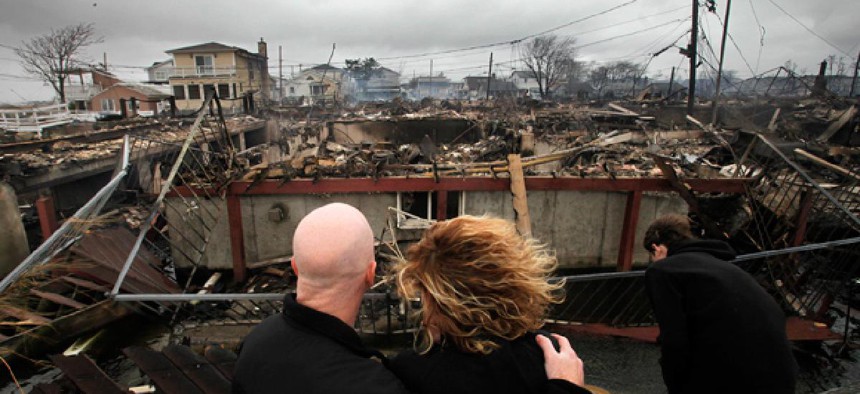
Mark Lennihan/AP
Widespread nature of Sandy prompted early disaster declarations, Fugate says
At least 1,500 FEMA employees joined other agencies in Monday’s response, administrator estimates.
President Obama’s decision early Tuesday to declare counties in New York and New Jersey as major disaster areas was “extraordinary,” according to Federal Emergency Management Agency Administrator Craig Fugate, because FEMA normally would “conduct a more thorough investigation.” But after Obama spoke with governors, it became clear there would be “widespread damage that exceeded the states’ capacity,” Fugate said.
The only other time the president has given such an early declaration was for American Samoa during a 2009 tsunami, the FEMA administrator said during a Tuesday conference call with reporters in the midst of response to the multisystem storm that has caused at least 29 deaths, left 6.5 million Americans without power, and caused an estimated $10 billion to $20 billion in damages, according to CNN.
The major declarations entitle counties to federal aid not only for pre-emptive forward positioning of supplies and first responders but also for the multimillion-dollar commitment of financial reimbursements for such expenses as National Guard mobilization and assistance to individual disaster victims.
Also extraordinary, Fugate said, was the way many of the governors participating in a conference call with the president and other officials said their own situations “are not that bad, and we don’t want to take away from states that are harder hit.” Several affected states offered up assistance to New York, New Jersey and Connecticut. Federal money and personnel coupled with the relative wealth of resources available to the mayor of New York City, he added, are examples of how the FEMA disaster response team works.
Describing FEMA’s coordinating role with state and local governments and private players, Fugate reviewed the efforts by “the federal family” to rush resources where needed, citing help from the Energy, Defense, and Health and Human Services departments, as well as the Army Corps of Engineers and Federal Communications Commission. He estimated that 1,500 FEMA employees were in action Monday and that the total number of mobilized federal employees is rising rapidly. Energy is working with private power companies to restore power, while HHS’ Centers for Disease Control and Prevention is moving in to get hospitals and nursing homes back in service, he said.
Fugate said the National Weather Service had provided an overlay map that helped with the disaster declaration decisions and the current effort, prompted by past problems, has better “fraud control built into it” so that housing inspectors will travel to verify damage at residences that have applied for assistance “without producing an unfair burden on people who are in need of help.” He said the adequacy of the National Flood Insurance Program, still billions in debt from past disasters such as Hurricane Katrina in 2005, will be reassessed after the Sandy situation as stabilized.
National Hurricane Center Director Rick Knabb on the same call said Sandy, as it has moved into Western Pennsylvania, is “still a very large system that has been impacting U.S. coastal areas less today than last night, but those effects are not zero.” He cited “fairly strong winds coming from the south” up to New England that could raise water levels two to four feet at times of high tide and create minor coastal flooding. He cited high-speed winds and as much as a foot of rain as far west as Lake Michigan and as north to the coast of Maine before the storm moves into Canada on Wednesday. Snow in West Virginia could reach two to four feet in some areas, he added, and there is a widespread risk of river flooding in western New Jersey and Pennsylvania.
Coast Guard Vice Adm. Robert Parker said two ships 100 miles off Cape Hatteras, N.C., are still searching for the missing master of the replica of a historic 18th-century ship Bounty, battling 18-foot waves. He said the Coast Guard on Tuesday had succeeded in reopening the port of Norfolk, Va., to commerce and is working on other ports northward up to Narragansett Bay, R.I. “There are still a lot of challenges in New York and New Jersey,” he added, “because it’s hard to reach those infrastructures.”
On its website, FEMA also announced that a scheduled think tank conference call for public and private sector emergency management experts has been postponed because of the Sandy’s severity.







